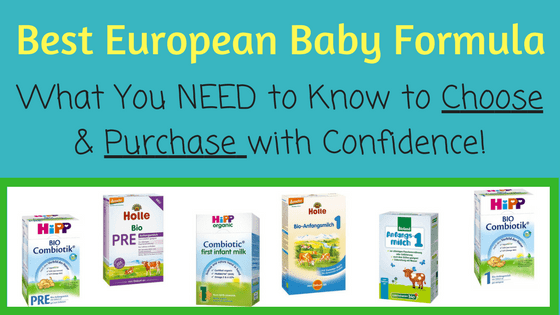
Baguettes from France are just better. The sausage (and beer!) from Germany kicks my supermarket’s butt. The pasta in Italy is far superior to the elbow noodles in my pantry. The port wine from Portugal … you get it…..
European Formula. Most people think of baby formula from Europe in the same way – that it’s far superior to US formula. When I probe parents who want this often-illusive European formula about why they prefer a European brand –the answers is usually some form of:
“It’s better regulated” or “the ingredients are cleaner”.
Both of these answers are true from a certain perspective. But honestly, it’s real real hard to find clear information about what makes European formula different from (or better than) US formula. There are lots of blogs that give generic differences (like packaging) and hit on the organic issue. But no one seems to be discussing differences in regulatory guidelines or required ingredients or how to get is safely – pretty big issues!
Well, we are gonna crush that topic. In this article, I am going to:
- Break down the differences in regulations and practices between the US and EU formulas.
- Cover the differences in nutrition requirements that could make a big difference for your baby.
- Tell you what you need to know before importing a European formula.
- Break down the differences between the 3 popular brands of European formula: Holle, HiPP and Lebenswert.
Differences between USA and European Formula Industry:
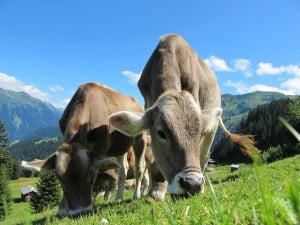
1) Farming Practices
The short summary is: generally speaking, the EU farming practices are just better from an animal standpoint. The governing body of European formula regulation is the European Commission (equivalent to the FDA in the US). They require that there be no detectable levels of pesticide residues in any infant formula. This means that all European formulas are organic from a pesticide perspective.
Many of the EU formulas are made from milk cows living on a Demeter farm. Demeter is like organic++. It means the farm is “biodynamic” – so no synthetic pesticides or fertilizers or GMO technology. The farming practices are sustainable, and the cows graze and consume their natural food source, which is grass. This makes for some healthy and happy cows! Grass-fed cows produce milk that may have additional benefits to infants, compared to cows raised on corn (like most in the US).
In the US, we now have two formulas that use milk from organic and grass-fed cows to make the formula (these are Bobbie and ByHeart formula). Hopefully we’ll see more US formulas like this in the future.
Lastly, farms used to produce ingredients for European formulas get major points for sustainability. This really doesn’t affect the nutrition the infant receives, but is worth mentioning since it is important to many families. Because many of the farms are biodynamic, they are also carbon-neutral, and you’ll see that phrase on some European formula’s packaging. Secondly, a few of the companies go out of their way to acquire palm oil from sustainable sources – which is not the norm for US formulas

2) Goat Milk Formula Is A Thing!
The EU is ahead of the US on the goat milk formula front. Goat’s milk is fully approved as a base for infant formula and widely available in the EU.
The main brands are Holle (a German company) and Nanny Care and Kendamil (British companies). If you want to get cracking learning more about goat milk formula, here is a video I made comparing goat milk protein vs cow milk protein in formula. And here is an article comparing Holle vs Nanny Care vs Kabrita goat milk formulas.
Goat milk formula hit the US market in 2022 when foerign formulas got temporary approval due to the infamous formula shortage. Some of these European goat milk formlas are still available, but its unclear how long they will be able to stay. In big news, in 2023, Kabrita announced they will be releasing the first FDA approved US goat milk formula! It’s very exciting to see a long-term goat milk option become available to US parents!!
3) European Formula Comes in Stages (This is BIG)
The EU handles formula totally differently than the FDA. In the US, the FDA regulates “Infant Formula” which is formula made for infants from birth – 12 months. The EU separates their formulas into 2 distinct stages:
- European “Infant Formula” is made for babies from birth to the beginning of solid foods (between 4 – 6 months). This is labeled Stage 1.
- European “Follow on Formula” is for infants after solid foods have been started (between 4 – 6 months) until 1 year. This is labeled Stage 2.
The important thing to know is that: if you choose a European Formula, it’s pretty dang important to get the right stage for your baby’s age! The nutrition is much more tailored for specific age groups. This is quite different from US formulas, where I consider the whole stage approach to be mostly marketing and not really important.
Stage 3 European formulas are what we’d call “toddler formulas”. I’m not going to cover those here since this article would be considered a book at that point.
Differences between USA and European Formula Regulations:
The European Commission regulates European formula, like the FDA regulates US formula. There are a lot of differences in the requirements and nutrients that you need to know about before making a switch.
First (as just mentioned), Europe does formula in stages. Secondly, they also have some special requirements for partially hydrolyzed and fully hydrolyzed protein formulas, since these formulas have a different protein base than just straight cow’s milk proteins (1, 2). The FDA doesn’t distinguish between types of formulas like this – there is only one set of requirements for all cow’s milk formulas – and these requirements are for any baby between the ages of birth to 12 months (3).
There’s lots of minor differences in the minimum and maximum ranges set for various vitamins and minerals. But, I’m just going to give you the major differences that differ between how US and European brands have chosen to adhere to these guidelines (so basically, the differences that matter).
1) Iron
Apparently Americans and Europeans have very different opinions on how much iron should go in baby formula (and how tight men’s jeans should be… but I digress). Here are the limits set by the two governing bodies:
- The FDA requires US infant formulas to have between 0.15 – 3.30 mg/100kcal iron.
- The European Commission requires European Infant Formula (babies 0 – 6 months) to have between 0.3 – 1.3 mg/100kcal iron.
- The European Commission requires European Follow-On Formula (babies 6 – 12 months) to have between 0.6 – 1.7 mg/100kcal iron.
The US range is just much larger than the European range. But here’s where the real difference comes into play. Most US formulas all seem to follow the classic “more is better” approach and add iron closer to the upper end of the range. For example, here are the iron concentrations in the major US brand formulas:
- Enfamil Enfamil Infant = 1.8 mg/100kcal
- Similac Advance (and Pro Advance) = 1.9 mg/100kcal
- Gerber Good Start GentlePro = 1.5 mg/100kcal
Notice that all of these US formulas have iron concentrations well above the maximum allowable concentrations set by the EU for babies 0-6 months. In fact, my lab published a study showing that 96% of formula purchased in the US (pre COVID and shortage) had iron concentrations above the EU maximum allowable iron for Stage 1 formula (5). This is one of the biggest differences between the continents! You will obviously find different opinions on who is right and should discuss it with your pediatrician. But here’s what matters. If you are using a European formula, you really need to be using a “follow-on” formula (stage 2) once your baby is between 4 – 6 months of age to be sure they are getting enough iron in their diet. Focusing on iron-rich solid foods will also help! It’s a good conversation to have with your pediatrician who will know all of your unique baby’s risk factors for potential iron deficiency.
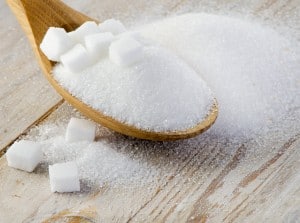
2) Sugar and Lactose
I prefer to see lactose as a startign carbohydrate in formula (and prefer to not see sugar (or sucrose) listed, if possible). I am happy to say that Europe agrees with me! European cow’s milk formulas with intact proteins (which is most formulas) cannot have any sucrose at all! Formulas made from hydrolyzed proteins are allowed to have a little sucrose, but no more than 20%. PLUS the European Commission sets a minimum concentrations of lactose so that all formulas have to have at least 30% carbohydrate from lactose. The FDA doesn’t have any such requirements – regarding sucrose, or %lactose. Lots of the “sensitive” formulas in the US would violate this %lactose rule. So there’s that ….
3) DHA
In 2015, the EU passed regulation requiring DHA (a long-chain fatty acid) to be added to all infant formula and all follow-on formula to at least 20mg/100kcal (which is super high (4))! They had until 2020 to put this into effect. DHA is not required in US formula, almost all formulas add it. Even though DHA is not required, if it is added to formula in the US, it must be accompanied by ARA (another fatty acid) to help optimize baby’s fatty acid metabolism. ARA is not required to be added to European formulas, although many companies do add it. What’s this mean? It means that EU formulas have way more DHA than US formulas. In fact, of all formula purchased in the US between 2017-2019, ZERO formulas had enough DHA to meet EU minimums (5).
While this is intersting, I personally don’t think this is the most important thing to consider for a healthy term baby. You know I prefer you focus on the protein and carbohydrate sources to maximize your baby’s comfort. THEN you will sleep better and have enough bandwidth to start worrying about DHA
4) Other Ingredients
- The Europeans are a little more conservative with their additives than we are. They do not allow any of the following additives to be used in European Formula: locust gum, guar gum, pectins, fructans (like inulin), and carrageenan. Carrageenan is commonly found in US ready-to-feed formulas.
- L-Carnitine is required in European infant formulas (so for 0-6 months) that are partially hydrolyzed. The US doesn’t require it at all.
- Inositol is only required in European infant formulas (so for 0-6 months). It’s not required in the follow-on formula. The US also requires it – and so it’s in all formula in America.
- European formulas have different “extras” than American formulas. In the US, you often see carnitine, taurine or nucleotides added to formula. These are not found in any of the main European cow’s milk formulas (HiPP, Holle, or Lebenswert). However, it is common to see single amino acids added to European formulas, particularly phenylalanine, tryptophan, and tyrosine. None of these are required, but they are often added. I point out which formulas add which amino acids in the brand breakdown below.
What You Need to Know Before Importing A European Formula:
1) Third Party Suppliers are not regulated!!
European formula is technically “illegal” in the US since it is not FDA regulated. The only (temporary) exceptions are those formulas that were imported during the shortage (list here). These do NOT include HiPP and Holle. All other EU formulas are considered “gray market”. It’s important to consider the risks involved with going with one of these brands … discussed below:
2) Accurate Information is hard to come by!
Well – obviously this article rocks 🙂 But, accurate lists of ingredients are hard to find! I often have to rely on third party websites to find ingredients, or try to translate foreign labels into English. None of this is ideal! It’s important to know that what you get is what you think you are getting! A good supplier will help with this (more on that below). Also, the EU recently passed regulation that will require more foreigner-friendly labeling for us American parents since there has been so much exporting of European formula over the last few years. This is awesome!

3) All Countries in Europe Are Not The Same
HiPP formula has manufacturers in 3 different countries: The United Kingdom, Germany, and The Netherlands. All make HiPP Stage 1 and Stage 2 formulas. While they are similar – they are not the same!!! HiPP Stage 1 from the Netherlands & Germany has a probiotic while UK HiPP Stage does not. The Dutch HiPP is soy-free whereas the German and UK HiPP are not.
So, it’s important that you know which specific country you would like to order. And it’s equally important to use a supplier that will not just lump all HiPP formula together and allow you to specify the type you want. Otherwise, your baby could end up going through many inadvertent formula switches, which can be stressful!
4) Pediatrician comfort
Some US pediatricians are just uncomfortable using European formula. This is for a variety of reasons. The biggest is: European formulas adhere to EU standards and are approved in Europe – so they do not go through the FDA vetting process and are thus NOT FDA approved “infant formulas” in the US. Your relationship with your pediatrician is sacred! You guys need to be a tight team. So be sure to have the discussion with your pediatrician. Show them this article if helpful! But just be sure you are using a formula that you are all comfortable with.
What To Look For in A European Formula Supplier:

So, you’ve made the decision to use a (non-shortage approved) European Formula. Now you’ve got to go about the terrifying task of ordering it over the internet. There are lots of suppliers online. There are also a lot of horror stories online about 4-week shipping times, orders that were never filled, and damaged packaging arriving. This is scary because it’s your baby we’re talking about! So here are the things to look for in a formula supplier/vendor to feel comfortable getting started.
- Supply Chain – Look for a company with a good supply chain. This means that they have established relationships with European suppliers so they have consistent inventory coming into the States in a timely manner.
- Only import via air – Look for a supplier that only imports formula via air freight (and not shipping across the ocean). This ensures the formula arrives faster and is not subject to potentially high heat/humidity levels on a cross-Atlantic ship.
- Local Inventory – Look for a supplier that stores formula in a temperature controlled US warehouse – so it is shipped to you from somewhere in the US (not directly from overseas). This way, you don’t end up with an unanticipated 3-week shipping time. Also local inventory will be kept updated, so if something is out of stock, you will know right away and not learn about a backorder 2 weeks after placing your order.
- Variety of options – Look for a supplier that specifically states which country HiPP they are selling so you don’t end up with formulas manufactured in different countries.
European Formula Brand Breakdown:
We’re finally here! Now that you have all the background, we can actually talk about the differences between the major European brand offerings: HiPP, Holle, Lebenswert and Kendamil.
We do have legally available US (and Aussie) formula still available in the US right now due to the shortage. These are a great legal alternative to third party EU formula suppliers. Here’s a link to the ingredient breakdown of all those formulas. (You’re welcome love!)
| Formula | Protein | Carb | Fat | Extras | Amino Acids | Iron* | Notes |
|---|---|---|---|---|---|---|---|
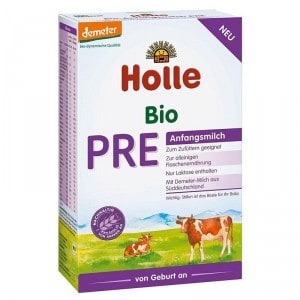 Holle PRE Holle PRE |
Whole Milk, Whey, Skim Milk | Lactose | Cream, Palm oil, Rapeseed oil, Sunflower oil | None | None | 0.5 | Organic, Demeter & Carbon Neutral |
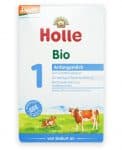 Holle – 1 Holle – 1 |
Skim Milk, Whey | Lactose, Maltodextrin | Palm, Rapeseed, Sunflower oils | None | None | 0.6 | Organic, Demeter & Carbon Neutral |
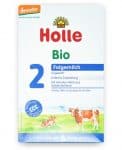 Holle – 2 Holle – 2 |
Skim Milk, Whey | Lactose, Maltodextrin, Starch | Palm, Rapeseed, Sunflower oils | None | None | 0.9 | Organic, Demeter & Carbon Neutral |
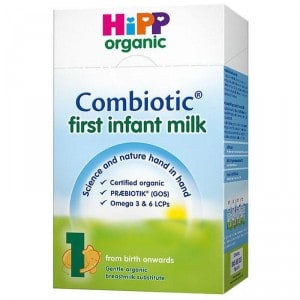 HiPP – 1 (UK) HiPP – 1 (UK) |
skimmed milk, whey powder (60/40 whey/casein ratio) |
Lactose | Palm, Rapeseed, Sunflower oils | GOS (prebiotic) | L-tyrosine, L-phenylalanine, L-tryptophan | 0.5 | Organic |
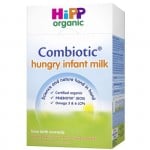 HiPP – 1 Hungry (UK) HiPP – 1 Hungry (UK) |
skimmed milk (80/20 whey/casein ratio) |
Lactose | Palm, Rapeseed, Sunflower oils | GOS (prebiotic) | L-cysteine, L-tryptophan | 0.7 | Organic, Soy-Free |
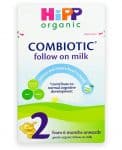 HiPP – 2 (UK) HiPP – 2 (UK) |
skimmed milk, whey powder | Lactose | Palm, Rapeseed, Sunflower oils | GOS (prebiotic) | L-tryptophan | 1.0 | Organic, Soy-Free |
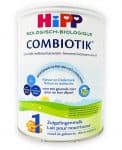 HiPP – 1 (Dutch) HiPP – 1 (Dutch) |
skimmed milk, whey powder | Lactose | Palm, Rapeseed, Sunflower oils | GOS (prebiotic), L. Fermentum (probiotic) | L-tyrosine, L-phenylalanine, L-tryptophan | 0.5 | Organic, Soy-Free |
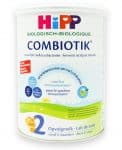 HiPP – 2 (Dutch) HiPP – 2 (Dutch) |
skimmed milk, whey powder | Lactose | Palm, Rapeseed, Sunflower oils | GOS (prebiotic), L. Fermentum (probiotic) | L-tryptophan | 1.0 | Organic, Soy-Free |
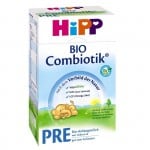 HiPP PRE – (German) HiPP PRE – (German) |
Skim Milk, Whey Product, Whey Protein | Lactose | Palm, Rapeseed, Sunflower oils | GOS (prebiotic), L. Fermentum (probiotic) | L-phenylalanine, L-tryptophan | 0.5 | Organic, Soy-Free |
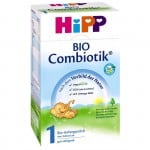 HiPP – 1 (German) HiPP – 1 (German) |
Skim Milk, Whey | Lactose | Palm, Rapeseed, Sunflower oils | GOS (prebiotic)
L. Fermentum (probiotic) |
L-tyrosine, L-phenylalanine, L-tryptophan | 0.5 | Organic |
 HiPP – 2 (German) HiPP – 2 (German) |
Skim Milk, Whey | Lactose, Starch | Palm, Rapeseed, Sunflower oils | GOS (prebiotic)
L. Fermentum (probiotic) |
L-tryptophan | 1.0 | Organic |
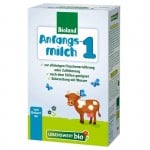 Lebenswert – 1 Lebenswert – 1 |
Skim Milk, Whey | Lactose | Palm, Rapeseed, Sunflower oils | None | None | 0.7 | Organic, Soy-Free |
 Lebenswert – 2 Lebenswert – 2 |
Skim Milk, Whey | Lactose, Maltodextrin | Palm, Rapeseed, Sunflower oils | None | None | 0.9 | Organic, Soy-Free |
 Kendamil – 1 Kendamil – 1 |
Whole Milk, Whey (60/40 whey/casein ratio) |
Lactose | Milk fat, Sunflower, Coconut, Rapeseed, oils | GOS (prebiotic) | None | 1.1 | Organic, Soy-Free |
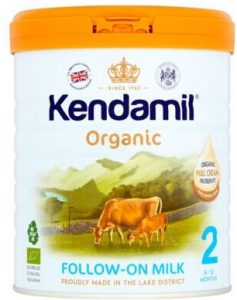
Kendamil – 2 |
Whole Milk, Whey (50/50 whey/casein ratio) |
Lactose | Milk fat, Sunflower, Coconut, Rapeseed, oils | GOS (prebiotic) | None | 1.2 | Organic, Soy-Free |
You are amazing for making it this far! I know it’s so hard choosing the right formula for your precious baby! You should feel really good about everything you just learned that will help you make the perfect choice.
Happy digesting to the tiny tummies in your house,
xo, Dr. Young
References:
- European Food Safety Authority (EFSA) Panel on Dietetic Products, Nutrition and Allergies (NDA). Scientific Opinion on the Essential Composition of Infant and Follow-on Formulae. EFSA Journal 2014; 12(7): 3760.
- European Commission; Health and Consumer Protection Directorate – General. Scientific Committee on Food. Report of the Scientific Committee on Food on the Revision of Essential Requirements of Infant Formulae and Follow-on Formulae. 2003: AXFR/CS/NUT/IF/65 Final. Brussels, Belgium.
- US Food and Drug Administration. Title 21 – Food and Drugs, Chapter I – Food and Drug Administration Department of Health and Human Services, Subchapter B – Food for Human Consumption, Part 107 – Infant Formula. Code of Federal Regulations. Title 21 (2): April 1, 2017.
- The European Commission. Commission Delegated Regulation (EU) 2016/127. September 25, 2015.
- Strzalkowski et al. Iron and DHA in Infant Formula Purchased in the US Fails to Meet European Nutrition Requirements. Nutrients. 2023; Apr 8;15 (8): 1812.

